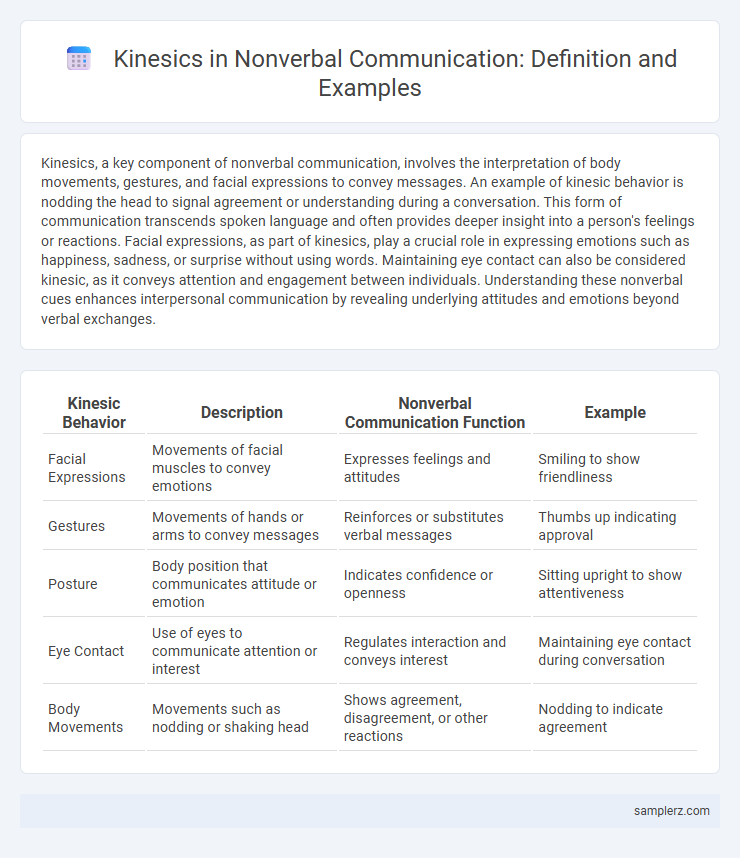Kinesics, a key component of nonverbal communication, involves the interpretation of body movements, gestures, and facial expressions to convey messages. An example of kinesic behavior is nodding the head to signal agreement or understanding during a conversation. This form of communication transcends spoken language and often provides deeper insight into a person's feelings or reactions. Facial expressions, as part of kinesics, play a crucial role in expressing emotions such as happiness, sadness, or surprise without using words. Maintaining eye contact can also be considered kinesic, as it conveys attention and engagement between individuals. Understanding these nonverbal cues enhances interpersonal communication by revealing underlying attitudes and emotions beyond verbal exchanges.
Table of Comparison
| Kinesic Behavior | Description | Nonverbal Communication Function | Example |
|---|---|---|---|
| Facial Expressions | Movements of facial muscles to convey emotions | Expresses feelings and attitudes | Smiling to show friendliness |
| Gestures | Movements of hands or arms to convey messages | Reinforces or substitutes verbal messages | Thumbs up indicating approval |
| Posture | Body position that communicates attitude or emotion | Indicates confidence or openness | Sitting upright to show attentiveness |
| Eye Contact | Use of eyes to communicate attention or interest | Regulates interaction and conveys interest | Maintaining eye contact during conversation |
| Body Movements | Movements such as nodding or shaking head | Shows agreement, disagreement, or other reactions | Nodding to indicate agreement |
Understanding Kinesics in Nonverbal Communication
Kinesics, the study of body movements and gestures, plays a crucial role in nonverbal communication by conveying emotions and intentions without words. Examples include facial expressions, posture, eye contact, and hand gestures, which can indicate confidence, nervousness, or openness. Understanding these kinesic cues enhances interpersonal interactions by providing deeper insight into unspoken feelings and social dynamics.
Importance of Body Language in Human Interaction
Kinesics, the study of body language, plays a vital role in human interaction by conveying emotions and intentions without words. Facial expressions, gestures, and posture provide critical nonverbal cues that enhance understanding and build rapport between individuals. Mastering body language awareness can improve communication effectiveness and prevent misunderstandings in both personal and professional settings.
Facial Expressions: Conveying Emotions Without Words
Facial expressions play a crucial role in nonverbal communication by conveying emotions such as happiness, anger, sadness, and surprise without the need for spoken words. Microexpressions, brief involuntary facial movements, reveal genuine feelings even when individuals attempt to mask them. Understanding these subtle cues enhances interpersonal interactions and emotional intelligence in both personal and professional communication.
Gesture Examples in Everyday Communication
Gestures such as waving, nodding, and thumbs-up serve as powerful kinesic examples in everyday communication, conveying messages without words. These nonverbal cues enhance understanding by expressing agreement, approval, or greeting in diverse social interactions. The use of culturally specific gestures also influences the effectiveness and interpretation of communication across different communities.
Posture and Its Role in Sending Messages
Posture plays a crucial role in nonverbal communication by conveying confidence, openness, or defensiveness without words. An upright and relaxed posture often signals attentiveness and receptivity, while slouched or closed positions may indicate disinterest or discomfort. Understanding these kinesic cues helps decode underlying emotions and intentions in interpersonal interactions.
Eye Contact: Power and Interpretation
Eye contact in kinesic communication signals power dynamics and influences interpretation between individuals. Sustained eye contact can indicate dominance, confidence, or assertiveness, while avoiding gaze might suggest submission or discomfort. Cultural differences impact the meaning of eye contact, making it essential to consider context for accurate nonverbal communication analysis.
The Meaning of Touch in Kinesic Communication
Touch in kinesic communication conveys powerful messages beyond words, such as comfort, dominance, or affection. A firm handshake often signals confidence and professionalism, while a gentle pat on the back can express support or encouragement. Cultural differences significantly influence the interpretation of touch, making context crucial for accurate understanding in interpersonal interactions.
Cultural Differences in Kinesic Signals
Kinesic signals such as eye contact, facial expressions, and gestures vary significantly across cultures, influencing communication effectiveness. In Western cultures, direct eye contact often signifies confidence and honesty, whereas in many Asian cultures, prolonged eye contact may be perceived as disrespectful or confrontational. Understanding these cultural differences in kinesics is crucial for avoiding misunderstandings and enhancing intercultural communication.
Common Misinterpretations of Body Language
Crossed arms often signify defensiveness but can simply indicate comfort or coldness. Avoiding eye contact may imply dishonesty, yet it also reflects cultural norms or shyness. Misreading gestures like a smile as friendliness overlooks contexts where it masks discomfort or sarcasm.
Enhancing Communication Skills Through Kinesics
Kinesics, the study of body language, significantly enhances communication skills by enabling individuals to interpret gestures, facial expressions, and posture accurately. Effective use of eye contact and mirroring posture fosters trust and improves interpersonal connections in both personal and professional settings. Mastering kinesic cues allows communicators to convey emotions and intentions clearly, reducing misunderstandings and strengthening message delivery.

example of kinesic in nonverbal Infographic
 samplerz.com
samplerz.com